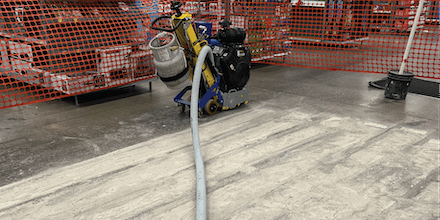Imagine you’re at the premier surface prep convention and someone asks, “What’s better to take down a slab of concrete, a shaver or a grinder?” Viewpoints could vary, right? Chances are, there would be more opinions tossed around than beach balls at a Jimmy Buffet concert. And to make matters worse, they could all be right! For the question itself is flawed. One might as well have asked what’s better between a toothbrush and a razor-blade. The fact is, it all depends on what you intend to do with the tool.
Although both shavers and grinders do essentially the same thing – remove surface material from concrete – they achieve their ends through radically different means. A 10” shaver uses a tight row of up to 66 diamond impregnated blades to cut into the concrete at a vertical (perpendicular) angle, removing up to 1/2” of material in a single pass. In contrast, a grinder spins horizontally against (parallel to) the concrete, using diamond impregnated tooling for a smoother finish, or bush hammers, for a more aggressive, albeit rougher cut. Think of it as using a chisel vs. sander on a block of wood. A chisel is going to get you deeper, faster, but there is an upper limit to the smoothness compared to a finer grit sandpaper. The same concept can be applied to shavers and grinders.
If you are looking for rapid aggregate exposure and intend to polish, then a concrete shaver such as the Von Arx DTF25 SH, electric or propane, would be an excellent pick, as it will leave you with a nice profile to smooth out. On the other hand, if you are aiming for a shallow, salt-and-pepper profile, or want to use a single machine for both removal and polishing, then you might want to consider a grinder, such as the RSP Spyder Quad. Either way, it makes good sense to tailor the means to the ends and let your big machines do what they do best. And yeah, even Jimmy Buffet has something to say about that. “I can’t change the direction of the wind, but I can adjust my sails to always reach my destination.”
